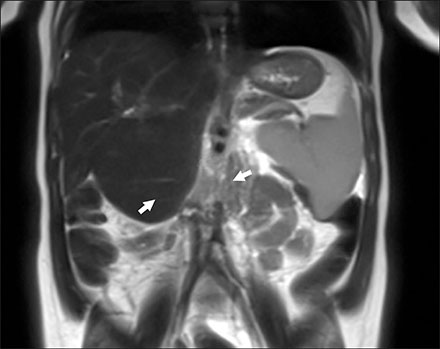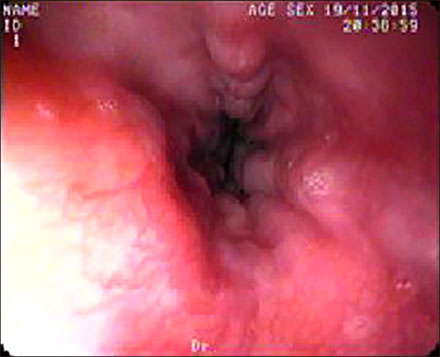Pediatr Gastroenterol Hepatol Nutr.
2018 Oct;21(4):361-364. 10.5223/pghn.2018.21.4.361.
Accessory Hepatic Lobe: A Rare Cause of Prehepatic Portal Hypertension in a Child
- Affiliations
-
- 1Department of Pediatric Gastroenterology, Hepatology and Nutrition, Faculty of Medicine, Karadeniz Technical University, Trabzon, Turkey. drturkmen61@ gmail.com
- 2Department of Radiology, Faculty of Medicine, Karadeniz Technical University, Trabzon, Turkey.
- 3Department of Pediatric Surgery, Faculty of Medicine, Karadeniz Technical University, Trabzon, Turkey.
- KMID: 2422002
- DOI: http://doi.org/10.5223/pghn.2018.21.4.361
Abstract
- Accessory hepatic lobe is noted as and considered a rare disease in children. It can manifest with various symptoms and complications depending on the location, volume, type and position of the disease as presented on a child. The patient presented as a 14-month-old girl who was seen with a notable hepatosplenomegaly and portal hypertension. A diagnosis was made after taking an extensive medical history, observation and radiological examinations. The formal diagnosis was a prehepatic portal hypertension associated with accessory hepatic lobe.
Keyword
Figure
Reference
-
1. Carrabetta S, Piombo A, Podestà R, Auriati L. Torsion and infarction of accessory liver lobe in young man. Surgery. 2009; 145:448–449.
Article2. Tancredi A, Cuttitta A, de Martino DG, Scaramuzzi R. Ectopic hepatic tissue misdiagnosed as a tumor of lung. Updates Surg. 2010; 62:121–123.
Article3. Mehta V, Arora J, Manik P, Suri RK, Rath G. Clinicoanatomical aspects of accessory fissures obscuring the normal hepatic morphology. Clin Ter. 2010; 161:259–260.4. Glenisson M, Salloum C, Lim C, Lacaze L, Malek A, Enriquez A, et al. Accessory liver lobes: anatomical description and clinical implications. J Visc Surg. 2014; 151:451–455.
Article5. Chavhan GB, Parra DA, Mann A, Navarro OM. Normal Doppler spectral waveforms of major pediatric vessels: specific patterns. Radiographics. 2008; 28:691–706.
Article6. Pujari BD, Deodhare SG. Symptomatic accessory lobe of liver with a review of the literature. Postgrad Med J. 1976; 52:234–236.
Article7. Garba ES, Ameh EA. Isolated rupture of an accessory liver from blunt abdominal trauma in childhood. Pediatr Surg Int. 2002; 18:62–63.
Article8. Akbulut S, Cakabay B, Sevinc MM, Basak F. Gastric outlet obstruction caused by Riedel's lobe of the liver: a diagnostic and therapeutic challenge for surgeons. Hepatogastroenterology. 2011; 58:589–592.9. Matley PJ, Rode H, Cywes S. Portal vein obstruction by ectopic liver tissue. J Pediatr Surg. 1989; 24:1163–1164.
Article10. Chandramohan A, Pachuau EL, Eapen A. Accessory hepatic lobe: a rare cause of extra-hepatic portal vein obstruction. Trop Gastroenterol. 2014; 35:190–193.
Article11. Wang C, Cheng L, Zhang Z, Xie T, Ding H, Deng Q, et al. Accessory lobes of the liver: A report of 3 cases and review of the literature. Intractable Rare Dis Res. 2012; 1:86–91.
Article



